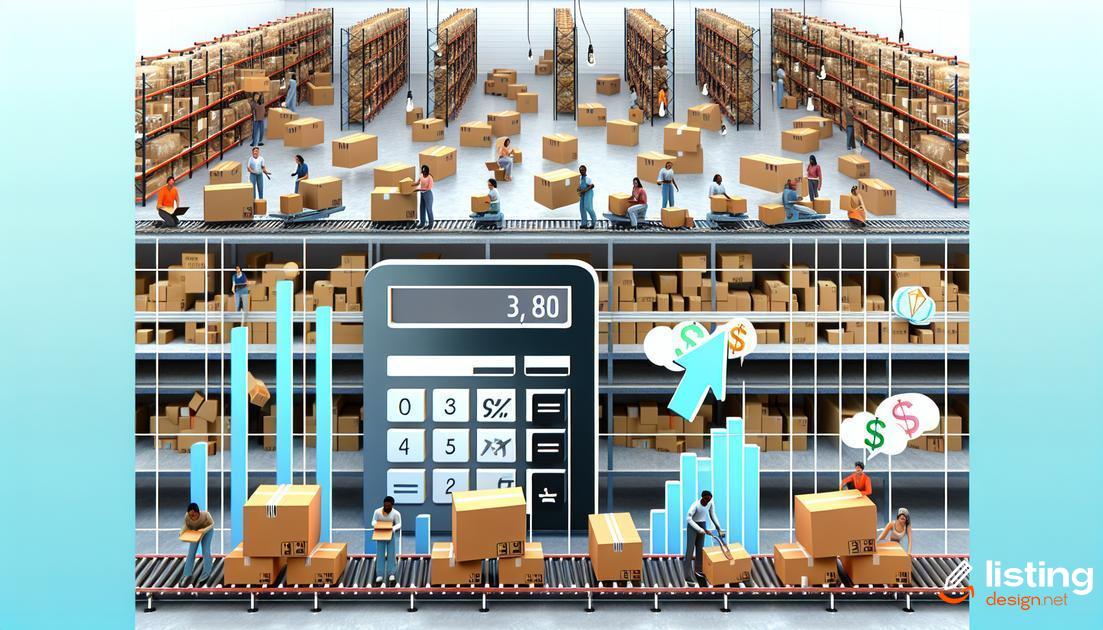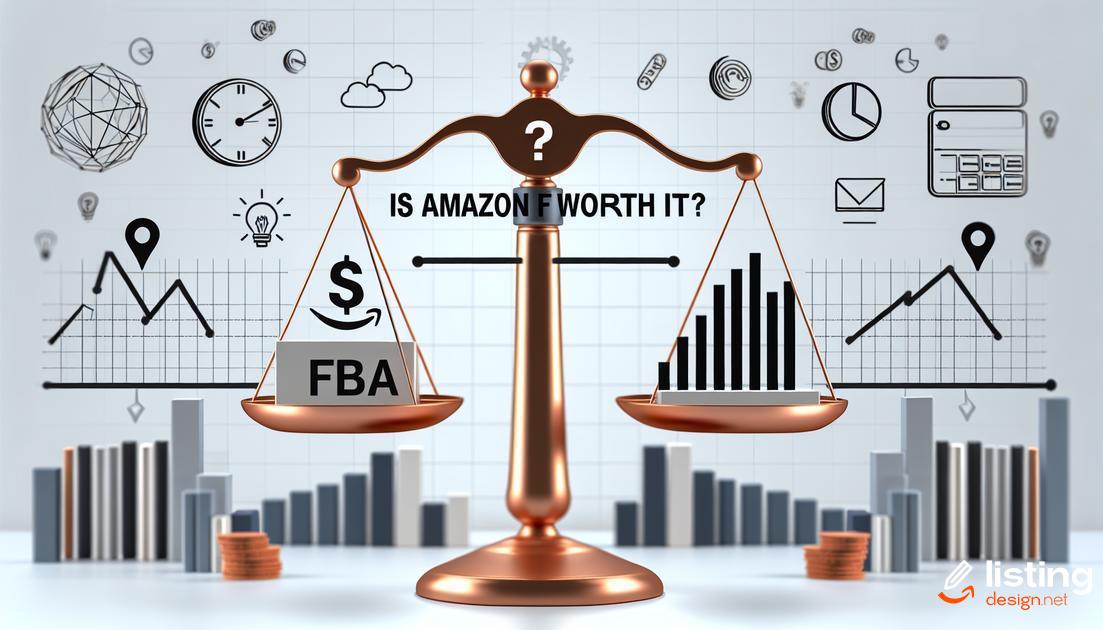Is Amazon FBA worth it in 2024? Many entrepreneurs ask this question before diving into the program. In this blog post, we will explore the key benefits, potential drawbacks, and financial aspects of using Amazon FBA. By understanding these factors, you’ll be better equipped to decide if Amazon FBA is the right path for your business.
Table of Contents
What is Amazon FBA?
Amazon FBA (Fulfillment by Amazon) is a service that allows sellers to store their products in Amazon’s fulfillment centers. Amazon takes care of storage, packaging, and shipping, as well as customer service and returns. Sellers send their products to Amazon’s warehouses, and when a customer places an order, Amazon handles the logistics, ensuring fast delivery and reliable service.
FBA leverages Amazon’s extensive distribution network, providing sellers with access to Prime shipping benefits and trusted customer service. Products listed under FBA are often eligible for Amazon Prime and Super Saver Shipping, enhancing their visibility and appeal to customers.
By using FBA, sellers can scale their business rapidly without worrying about handling the logistics themselves. This model allows businesses of all sizes to compete in the marketplace, taking advantage of Amazon’s infrastructure to increase sales and customer satisfaction.
How It Works
Sellers must first create an Amazon seller account and choose the FBA option. Then, they list their products on Amazon and prepare them for shipment to Amazon’s fulfillment centers. Amazon provides guidelines on packaging and labeling to ensure smooth processing. Once the products are in the fulfillment centers, Amazon takes over the rest, from storage to delivery.
Inventory Management
Amazon uses advanced technology to manage inventory, ensuring that products are stored efficiently and delivered promptly. Sellers can track their inventory and sales through the seller dashboard, which provides insights into stock levels, order fulfillment, and customer feedback.
Benefits of Amazon FBA in 2024

One of the standout benefits of Amazon FBA in 2024 is the convenience it offers. Handling logistics can be a massive headache, but Amazon takes care of storage, packaging, and shipping. This allows you to focus more on growing your business and less on mundane tasks.
Amazon’s Prime eligibility is another major benefit. Products listed through FBA automatically qualify for Amazon Prime, granting your items prime visibility and enhancing customer trust and convenience, which can lead to higher sales.
Another key benefit is access to Amazon’s vast customer base. Millions of shoppers trust Amazon, and as an FBA seller, you gain access to this enormous audience. This can significantly boost your sales compared to selling through your own site.
Amazon’s customer service is also a valuable asset. When you use FBA, Amazon handles all customer inquiries and returns, ensuring a smooth and positive experience for your customers without requiring your intervention.
Scalability is another impressive advantage. With Amazon managing logistics, you have the ability to quickly and efficiently scale your business. Whether you’re receiving hundreds or thousands of orders, Amazon can accommodate your needs without disrupting your workflow.
Potential Drawbacks You Must Know
Even with the numerous perks, there are some potential drawbacks to consider when using Amazon FBA. Knowing these will help you make an informed decision.
One significant drawback is the fees. Amazon FBA charges multiple fees for storage, fulfillment, and monthly service. These can add up, especially if your products don’t sell quickly. It’s crucial to understand all associated costs to maintain profitability.
Another issue is the lack of control. Once your inventory is in Amazon’s warehouses, you have limited control over how it’s managed. Issues such as lost shipments, mishandling, or delays can arise, impacting your customer satisfaction and business reputation.
Although Amazon handles customer service, returns can still be a pain point. Amazon’s policy can sometimes be too lenient, leading to higher return rates. This could result in a loss of revenue and potentially affect your seller rating.
Finally, competition is fierce on the platform. With millions of sellers, standing out can be tough. It’s vital to have a unique selling point, optimize your listings, and consider investing in advertising to get noticed.
Understanding these drawbacks will allow you to weigh them against the benefits, ensuring you make the best choice for your business strategy in 2024.
Costs Involved in Using Amazon FBA

Understanding the costs involved in using Amazon FBA is crucial for assessing its worth. One of the primary expenses is the fulfillment fee, which covers picking and packing orders, shipping, handling, customer service, and product returns. This fee varies depending on the size and weight of your products.
Another significant cost is the monthly storage fee. Amazon charges for storing your products in their fulfillment centers based on the volume they occupy. Additionally, there are long-term storage fees for items stored longer than 365 days.
Further, sellers must account for labeling fees, removal fees, and disposal fees for unsellable or returned products. If you choose to have Amazon prepare your products, there is also a prep service fee. Moreover, advertising costs can add up as running sponsored ads to increase visibility is often necessary.
Lastly, don’t forget about the cost of returns. Handling customer returns can be costly, including restocking fees and loss of inventory. Being aware of these costs upfront helps in making an informed decision on whether Amazon FBA aligns with your business goals.
Success Stories: Real Examples
Amazon FBA has paved the way for countless enterprises to flourish. One of the most notable success stories involves an entrepreneur who started with an investment of just $500 and, using FBA, scaled his business to over $1 million in annual sales within three years. His keen understanding of the market and leveraging Amazon’s extensive logistics network played a crucial role in this achievement.
Another remarkable example is a small brand specializing in eco-friendly products. Initially struggling with limited reach and high shipping costs, the company saw a 300% increase in sales after switching to Amazon FBA. Their products reached a broader audience, and customer satisfaction surged with timely deliveries and reliable service.
An inspiring story of a single mother who turned her passion for handmade jewelry into a thriving business also stands out. By utilizing Amazon FBA, she overcame the challenges of warehousing and shipping, allowing her to focus on product creation and customer relationships. Her revenue doubled within a year, proving that FBA can be a game-changer for small businesses and solo entrepreneurs alike.
Tips for Maximizing Profits with Amazon FBA

Understand Amazon’s Fees: Dive deep into Amazon FBA’s fee structure. Familiarize yourself with storage fees, fulfillment fees, and optional service fees to manage your finances effectively. This insight will help you price your products correctly, ensuring you cover all costs.
Optimize Product Listings: High-quality images, compelling product descriptions, and targeted keywords can significantly boost your sales. Regularly update your listings based on customer feedback and market trends to stay competitive.
Leverage Promotions and Discounts: Use Amazon’s promotional tools like Lightning Deals or Coupons to attract more customers. Strategic discounts can increase your product’s visibility and drive sales volume.
Monitor Inventory Levels: Consistently track your inventory to avoid stockouts or overstock situations. Utilize Amazon’s inventory management tools to maintain optimal stock levels, which can enhance your seller rating and customer satisfaction.
Focus on Customer Service: Satisfied customers are more likely to leave positive reviews and repeat purchases. Respond promptly to customer inquiries and resolve issues efficiently to build a loyal customer base.
Stay Updated with Trends: The e-commerce landscape is ever-evolving. Keep an eye on market trends, competitor strategies, and new opportunities to adjust your business approach accordingly. Staying informed can give you a competitive edge.
Alternatives to Amazon FBA
1. Shopify Fulfillment Network
For those seeking an alternative to Amazon FBA, the Shopify Fulfillment Network (SFN) is a strong contender. It offers a seamless integration with your Shopify store and provides end-to-end fulfillment solutions.
2. Fulfillment by eBay (FBE)
FBE is another option to consider if you’re looking to diversify your online selling channels. eBay’s fulfillment service can boost sales and provide efficient shipping management.
3. ShipBob
ShipBob has gained a reputation for its reliable and scalable fulfillment network. It offers transparent pricing and robust integrations with various eCommerce platforms.
4. FedEx Fulfillment
FedEx Fulfillment delivers a comprehensive solution that includes warehousing, packaging, and shipping. It also comes with the added benefit of using FedEx’s global shipping network.
5. Deliverr
If you are looking for fast and reliable shipping, Deliverr is worth investigating. It’s known for its competitive pricing and integration with major eCommerce platforms like Walmart and Shopify.
Is Amazon FBA Right for You?

Assess Your Business Model: Consider if your products are suited for Amazon’s FBA program. Typically, products that are lightweight, high-margin, and have steady demand perform better.
Evaluate Your Financial Situation: Running an FBA business requires upfront investment for inventory, shipping, and FBA fees. Be sure you have the financial bandwidth to handle these expenses.
Analyze Market Competition: Research your niche and competitors on Amazon. If the market is overly saturated, it might be challenging to gain visibility and sales.
Understanding the Fulfillment Requirements: Amazon FBA handles many logistical aspects, but you still need to comply with their stringent storage and shipping guidelines to avoid penalties and extra fees.
Time Commitment: Although FBA can relieve some operational burdens, managing product listings, responding to customer queries, and marketing remain your responsibilities. Assess if you have the time to dedicate to these tasks.
Risk Tolerance: Consider the possibility of product returns, unsold inventory, and other risks. Ensure you are comfortable with these potential downsides before committing fully to Amazon FBA.
Scalability: Amazon FBA can significantly aid in scaling your business, but only if it aligns with your overall business strategy. Determine whether your business model can grow within the FBA framework.


